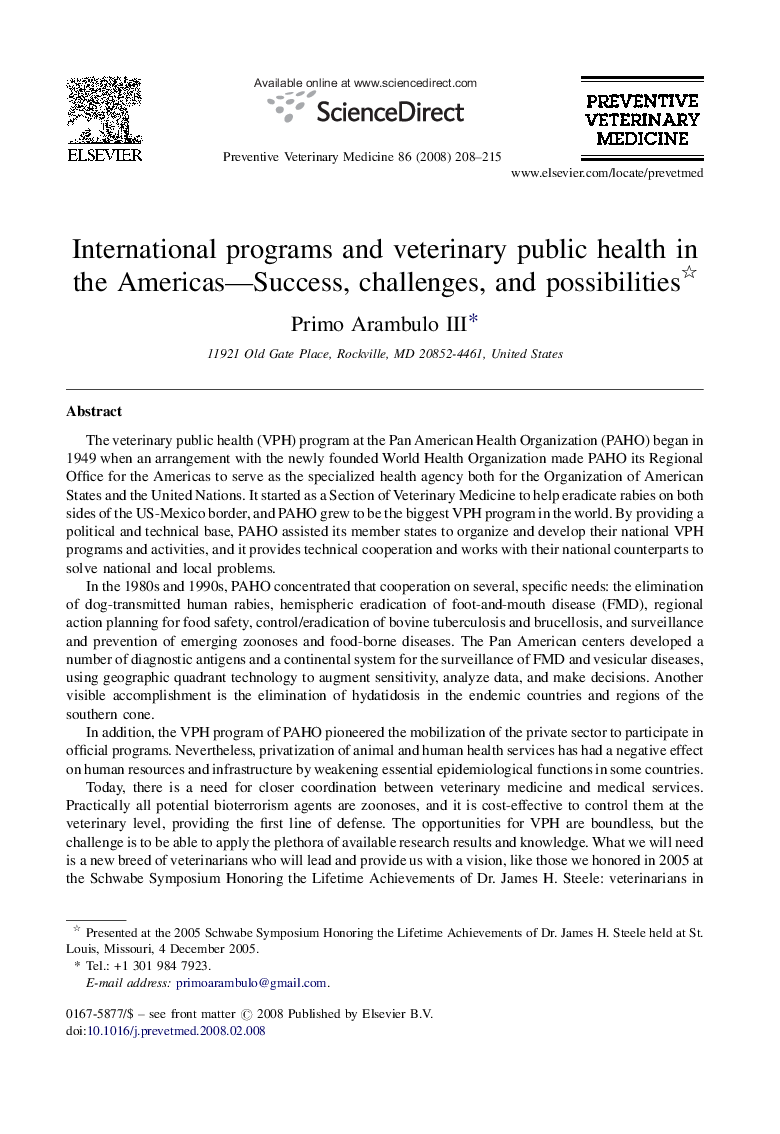| کد مقاله | کد نشریه | سال انتشار | مقاله انگلیسی | نسخه تمام متن |
|---|---|---|---|---|
| 2453288 | 1554214 | 2008 | 8 صفحه PDF | دانلود رایگان |

The veterinary public health (VPH) program at the Pan American Health Organization (PAHO) began in 1949 when an arrangement with the newly founded World Health Organization made PAHO its Regional Office for the Americas to serve as the specialized health agency both for the Organization of American States and the United Nations. It started as a Section of Veterinary Medicine to help eradicate rabies on both sides of the US-Mexico border, and PAHO grew to be the biggest VPH program in the world. By providing a political and technical base, PAHO assisted its member states to organize and develop their national VPH programs and activities, and it provides technical cooperation and works with their national counterparts to solve national and local problems.In the 1980s and 1990s, PAHO concentrated that cooperation on several, specific needs: the elimination of dog-transmitted human rabies, hemispheric eradication of foot-and-mouth disease (FMD), regional action planning for food safety, control/eradication of bovine tuberculosis and brucellosis, and surveillance and prevention of emerging zoonoses and food-borne diseases. The Pan American centers developed a number of diagnostic antigens and a continental system for the surveillance of FMD and vesicular diseases, using geographic quadrant technology to augment sensitivity, analyze data, and make decisions. Another visible accomplishment is the elimination of hydatidosis in the endemic countries and regions of the southern cone.In addition, the VPH program of PAHO pioneered the mobilization of the private sector to participate in official programs. Nevertheless, privatization of animal and human health services has had a negative effect on human resources and infrastructure by weakening essential epidemiological functions in some countries.Today, there is a need for closer coordination between veterinary medicine and medical services. Practically all potential bioterrorism agents are zoonoses, and it is cost-effective to control them at the veterinary level, providing the first line of defense. The opportunities for VPH are boundless, but the challenge is to be able to apply the plethora of available research results and knowledge. What we will need is a new breed of veterinarians who will lead and provide us with a vision, like those we honored in 2005 at the Schwabe Symposium Honoring the Lifetime Achievements of Dr. James H. Steele: veterinarians in public health who will be in the forefront of policy setting, decision-making, and allocation of resources, and veterinarians who will articulate and provide a strategic direction to our unique professional skills.
Journal: Preventive Veterinary Medicine - Volume 86, Issues 3–4, 15 September 2008, Pages 208–215